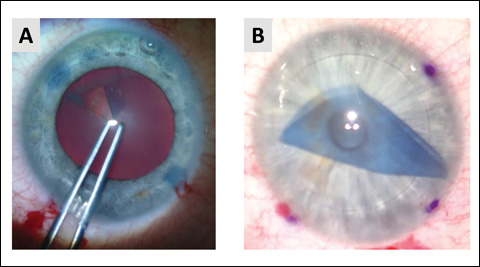Why is DMEK considered so difficult?
Surgeons may be deterred by not knowing the specific 'next steps' of the operation.
The most common reason cited for the slow adoption of Descemet’s membrane endothelial keratoplasty, particularly in the United States, is the perceived difficulty of the surgery and, specifically, the intraoperative challenges associated with graft unfolding.


This is a somewhat strange but extremely persistent objection. Despite the fact that the whole operation can be performed inside of 30 minutes (and the graft unfolding component in 5 minutes), with no special equipment, by a single unassisted surgeon, free of any awkward or dangerous maneuvers, and usually with only a few well-placed taps on the exterior surface of the cornea, this reputation of technical difficulty abides. Why?
There are perhaps many candidate explanations, but to us, the reason is this: With many other types of routine surgery — for example, cataract extraction — there are algorithms that specify the “next steps” of the whole operation. Most cases proceed unremarkably according to a certain script, and the most common intraoperative challenges can frequently be managed by invoking some well-known solution (for example, if the pupil is constricted, then a dilating device is implanted, or if the red reflex is poor, then a capsular stain is instilled). Well-established “if-this-then-that” decision trees guide most cases, and the surgeon often has plenty of time to consider various options.
On the other hand, consider DMEK. After the tissue is injected, it is often not evident what exactly should be done next (Figure 1). Certain objectives must be accomplished. The graft orientation must be confirmed, the edges unrolled, and the tissue lifted, but for any given tissue position or configuration, there is not an “if-this-then-that” algorithm to employ, like in cataract surgery. As a result, every single DMEK operation is an exercise in problem solving and, specifically, problem solving on a timer because the stain rapidly fades from the graft inside the eye. Problem solving on a timer can be a psychologically distressing experience, and this is perhaps why surgeons are sometimes less willing to perform straightforward DMEK than they are to undertake complex cataract surgery.

Source: Jack S. Parker, MD, PhD, and Gerrit R.J. Melles, MD, PhD
What might the solution be? Short of mandatory confidence training for all corneal surgeons, the only alternative appears to be to make DMEK more algorithmic — that is, to publish an extensive manual of graft positions with the precise next manipulations indicated, so that these positional solutions do not have to be discovered “on the fly” in every case. A book of “next moves” might be inherently idiosyncratic, but still, that may be preferable to the current state of confusion.
- For more information:
- Jack S. Parker, MD, PhD, can be reached at Parker Cornea, 700 18th St. South, Suite 503, Birmingham, AL 35233; email: jack.parker@gmail.com.
- Gerrit R.J. Melles, MD, PhD, can be reached at Netherlands Institute for Innovative Ocular Surgery (NIIOS), Laan op Zuid 88, 3071AA Rotterdam, Netherlands; email: melles@niios.nl.
Disclosures: Parker reports he is a consultant for DORC International/Dutch Ophthalmic USA and Ziemer Ophthalmic Systems. Melles reports he is a consultant for DORC International/Dutch Ophthalmic USA and SurgiCube International.
